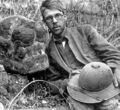Template:Selected anniversaries/September 3: Difference between revisions
No edit summary |
No edit summary |
||
| Line 39: | Line 39: | ||
|File:Cantor Parabola.jpg|link=Cantor Parabola|1929: Math photographer [[Cantor Parabola]] takes retro-temporal pictures of inventor [[Philo Farnsworth (nonfiction)|Philo Farnsworth]] demonstrating his electronic television system, revealing unexpected correspondences with other timelines. | |File:Cantor Parabola.jpg|link=Cantor Parabola|1929: Math photographer [[Cantor Parabola]] takes retro-temporal pictures of inventor [[Philo Farnsworth (nonfiction)|Philo Farnsworth]] demonstrating his electronic television system, revealing unexpected correspondences with other timelines. | ||
||1932: Gerald Neugebauer born ... astronomer and physicist, pioneering work in infrared astronomy. Pic search. | |||
||1942: Max Ernst August Bodenstein dies ... physical chemist known for his work in chemical kinetics. He was first to postulate a chain reaction mechanism and that explosions are branched chain reactions, later applied to the atomic bomb. Pic. | ||1942: Max Ernst August Bodenstein dies ... physical chemist known for his work in chemical kinetics. He was first to postulate a chain reaction mechanism and that explosions are branched chain reactions, later applied to the atomic bomb. Pic. | ||
| Line 48: | Line 50: | ||
File:Viking orbiter.jpg|link=Viking 2 (nonfiction)|1976: Viking program: The [[Viking 2 (nonfiction)|Viking 2]] spacecraft lands at Utopia Planitia on [[Mars (nonfiction)|Mars]]. | File:Viking orbiter.jpg|link=Viking 2 (nonfiction)|1976: Viking program: The [[Viking 2 (nonfiction)|Viking 2]] spacecraft lands at Utopia Planitia on [[Mars (nonfiction)|Mars]]. | ||
||1993: Henrik Selberg dies ... mathematician. He was born in Bergen as the son of Ole Michael Ludvigsen Selberg and Anna Kristina Brigtsdatter Skeie. He was a brother of Sigmund, Arne and Atle Selberg. He was appointed professor at the University of Oslo from 1962 to 1973. He is best known for his works on complex functions and potential theory. Pic search no | ||1993: Henrik Selberg dies ... mathematician. He was born in Bergen as the son of Ole Michael Ludvigsen Selberg and Anna Kristina Brigtsdatter Skeie. He was a brother of Sigmund, Arne and Atle Selberg. He was appointed professor at the University of Oslo from 1962 to 1973. He is best known for his works on complex functions and potential theory. Pic search no. | ||
File:Dennis_Paulson_of_Mars.jpg|link=Dennis Paulson of Mars|2017: ''[[Dennis Paulson of Mars]]'' celebrates the forty-first anniversary of the end of the [[Viking 2 (nonfiction)|Viking 2]] spacecraft landing at Utopia Planitia on [[Mars (nonfiction)|Mars]]. | File:Dennis_Paulson_of_Mars.jpg|link=Dennis Paulson of Mars|2017: ''[[Dennis Paulson of Mars]]'' celebrates the forty-first anniversary of the end of the [[Viking 2 (nonfiction)|Viking 2]] spacecraft landing at Utopia Planitia on [[Mars (nonfiction)|Mars]]. | ||
</gallery> | </gallery> | ||
Revision as of 03:55, 28 April 2020
1658: Oliver Cromwell dies. He was a military and political leader and later Lord Protector of the Commonwealth of England, Scotland, and Ireland.
1803: Chemist John Dalton uses symbols to represent the atoms making up molecules of different elements.
1814: Mathematician and academic James Joseph Sylvester born. He will make fundamental contributions to matrix theory, invariant theory, number theory, partition theory, and combinatorics.
1916: Archaeologist and crime-fighter Sylvanus Morley uses archaeological expedition to Mexico during World War I as cover story for secret investigation into alleged Maya-related crimes against mathematical constants.
1928: Inventor Philo Farnsworth demonstrates his electronic television system to the press.
1975: Vulnerability in Forbidden graph characterization exploited in blackmail scheme by criminal mathematician Anarchimedes.
2017: Dennis Paulson of Mars celebrates the forty-first anniversary of the end of the Viking 2 spacecraft landing at Utopia Planitia on Mars.







